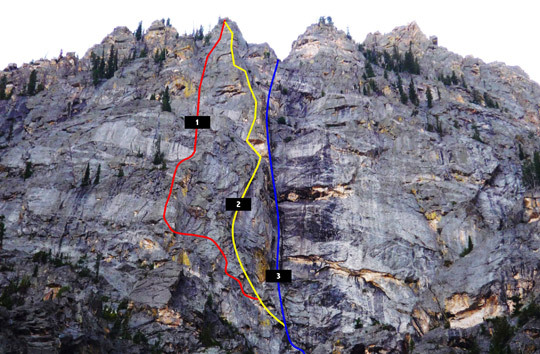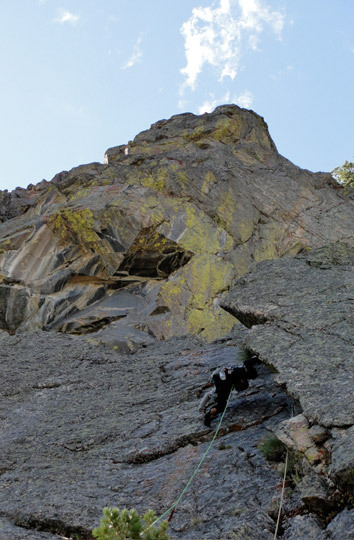
The upper northeast face of Prospectors Mountain, Death Canyon, Grand Teton National Park, Wyoming. On September 2, Mark Givens and Joel Kauffman ventured onto The Alien Wall (IV 5.10-, 7 pitches, 400m) to climb the park’s only recorded new rock route this summer. The Alien Wall is marked in red; routes 2 and 3 are Predator (IV 5.11 A2, Donini-Tackle) and Raven Crack (IV 5.9, Chouinard-Hempel). [Photo] Mark Givens
Two alpine routes were established ground-up recently in Grand Teton National Park, one pure rock on the upper northeast wall of Prospectors Mountain (11,241′) and another mixed on the north side of the Enclosure (13,280′).
Exum guide Mark Givens and Joel Kauffman climbed The Alien Wall (IV 5.10-, 7 pitches, 400m) on September 2. Paul Rachele and Landon Wiedenman, climbers familiar with the Tetons but with no new-routing experience, climbed Training Wheels (IV M4 AI3 5.6 A1) on August 12. Their 400 feet of new ground is a variation of the Visionquest Couloir (IV AI3+ 5.8).
The Alien Wall takes a direct line up the center of a striking wall, Givens said, left of Predator (IV 5.11 A2, Donini-Tackle) on the south side of Death Canyon. The canyon’s north side is home to popular multipitch crags such as Cathedral Rock and the Omega Buttresses; however, its south side is visited infrequently.

Kauffman climbs a stem corner on Pitch 5 of The Alien Wall. [Photo] Mark Givens
“That particular area has not received much attention,” Jenny Lake Sub-district Ranger Renny Jackson said of Death Canyon’s south side. “And that’s surprising because it’s such a big wall.”
Its rock quality is also underrated, Givens said. He and Kauffman were pleasantly surprised by the features: “The climbing was wild and varied for the grade,” Givens said on his blog. “Steep face climbing, stem-box corners, thin flakes, and cracks from cranking fingerlocks to a small offwidth section.”
Jackson expects news of The Alien Wall to draw more climbers to Death Canyon’s south side in subsequent seasons.
A month prior, Rachele and Wiedenman had climbed the Black Ice Couloir (IV AI3+ 5.7, 8 pitches), the Grand Teton’s classic ice route that has melted out significantly in recent decades, making the gully more susceptible to rockfall and unclimbable except in rare conditions. This summer Black Ice was in for the first time in about ten years. The two men had recently learned to ice climb; upon climbing the Black Ice, they encountered harrowing rockfall. Nonetheless, during their ascent Rachele picked out an unclimbed line that split from the Black Ice near the Visionquest and suggested the pair return to try it later in the season.
“There was no ice in it at the time,” Wiedenman recalled. “And I said, ‘Dude, you’re crazy.'”
The two later studied photographs and, after an early season snowfall, returned to the Grand. Rather than start up the Black Ice again, they rappelled from the Upper Saddle and found a safe belay stance. They drytooled up rock and ice-encrusted snow then took a second pitch of alpine ice that led into an offwidth. They climbed slabs and blocks above, aiding through one bulge, to reconnect with the upper section of Visionquest.
The climbers had neither hammered a piton nor cut a V-thread before the ascent, Wiedenman said. “Neither of us have a large scope of experience with mixed climbing, so it’ll be interesting to see what the consensus is.”
But Jackson suggested there may never be consensus: “That route might not have existed for the last ten years because the Black Ice had melted out so much,” he said. “Just that the route exists is the attraction.”

Paul Rachele works up Pitch 1 of Training Wheels (IV M4 AI3 5.6 A1), a 400-foot variation of Visionquest Couloir on the Enclosure, Grand Teton National Park, Wyoming. [Photo] Landon Wiedenman